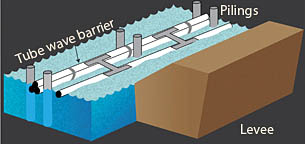This page has been archived and is being provided for reference purposes only. The page is no longer being updated, and therefore, links on the page may be invalid.
| Read the magazine story to find out more. |
|
|
|
|
Better Barriers Can Help Levees Withstand Wave Erosion
By Ann Perry
July 9, 2010
A new barrier design could protect reservoir levees from the erosive forces of wind-driven waves, according to studies by Agricultural Research Service (ARS) scientists and partners. These findings could help lower the maintenance costs for constructed ponds in the lower Mississippi Delta where levee repairs can average $3 per foot-and sometimes are needed just five years after a reservoir is built.
Hydraulic engineer Daniel Wren, who works at the ARS Watershed Physical Processes Research Unit in Oxford, Miss., partnered with ARS hydraulic engineer Carlos Alonso (now retired) and University of Mississippi research associate Yavuz Ozeren for his research. The team gathered data about wind and wave dynamics from a 70-acre irrigation reservoir in Arkansas. Then they took their data into the lab and designed several wave barriers that they tested in a 63-foot-long wave flume.
Their results indicated that a floating barrier held in place by two rows of pilings would provide the most effective embankment protection from wave action. Since the barrier was confined between the two rows of pilings, it could rise and fall with fluctuating water levels, unlike a barrier tethered to the bottom of the pond that might become submerged by rising water levels.
The team found that a two-pipe barrier was able to dissipate 75 percent of wave energy before the waves washed against the levees. The waves lost some of their force when they broke against the first tube and then lost even more energy as they broke against the second tube. The engineers also found that bundling several lengths of smaller tubing together to obtain an optimal diameter for the floating barrier was less expensive than purchasing one tube with a larger diameter.
Results from this research were published in the Transactions of the American Society of Agricultural and Biological Engineers.
Read more about this work in the July 2010 issue of Agricultural Research magazine.
ARS is the principal intramural scientific research agency of the U.S. Department of Agriculture.

